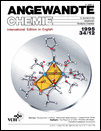1,5-Anhydrohexitol Nucleic Acids, a New Promising Antisense Construct†
This work was supported by a grant from the Fonds voor Geneeskunding Wetenschappelijk Onderzoek. A. V. A. is a Research Associate of the Belgian National Fund of Scientific Research. We thank Guido Schepers for his efficient technical assistance.
Graphical Abstract
Both natural oligoribonucleotides and oligodeoxynucleotides are hybridized sequence-selectively by hexitol nucleic acids (HNA) 1, which are composed of 1,5-anhydrohexitol nucleoside analogues linked by phosphate groups. Owing to the strongly increased duplex stability, these constructs should be pursued for potential applications as antisense agents.
Abstract
For corrigendum see DOI:10.1002/anie.199521651





